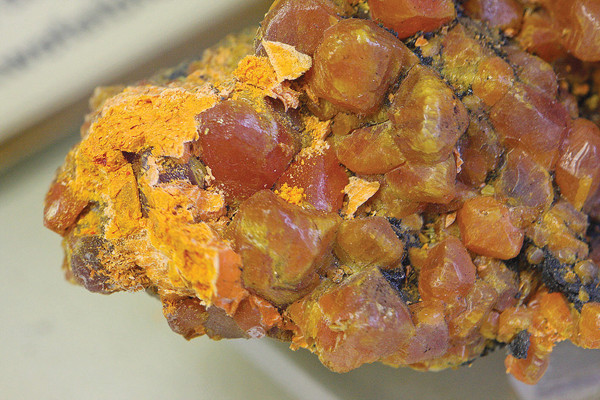
by U.S. Geological Survey Monday, August 4, 2014

The most common arsenic-containing minerals are arsenopyrite, realgar and orpiment (shown here). ©Elke Wetzig, CC BY-SA 3.0.
George Bedinger, mineral commodity specialist for the U.S. Geological Survey, prepared the following information on arsenic.
Arsenic is a gray metal rarely encountered as a free element, but is widely distributed in minerals and ores that contain copper, iron and lead. Arsenic is often found in groundwater as a result of the natural weathering of rock and soil.
Arsenopyrite, the most abundant ore mineral of arsenic, occurs in high-temperature hydrothermal veins, pegmatites and in contact metamorphic environments. Arsenic trioxide has been recovered from realgar and orpiment — which are found in low-temperature environments such as volcanic sublimations, low-temperature hydrothermal veins and hot springs. It has also been recovered from enargite, a copper mineral, from copper-gold ores, and has been associated with gold occurrences.
The principal use of arsenic trioxide, or “white arsenic,” is the production of chromated copper arsenide, a preservative used in treating lumber for nonresidential applications. The 2004 voluntary ban on the use of arsenic in treated lumber in residential applications, due to carcinogenic and toxicity concerns, led to a sharp decline in domestic consumption. Similar reductions have occurred in the use of arsenic chemicals in agricultural herbicides, insecticides, feed additives and desiccants.
Arsenic metal, recovered through reduction of white arsenic, is used as an antifriction additive for bearings, to harden lead shot, in clip-on wheel weights and in other nonferrous alloy applications. High-purity arsenic (99.9999 percent) is used in the electronics industry to produce the gallium arsenide semiconductors used in solar cells, space research, telecommunications and smartphones.
The World Health Organization (WHO) lists arsenic in the top ten chemicals of major public health concern owing to its widespread presence and its contamination of groundwater supplies. In the United States, exposure to arsenic in drinking water has been identified as a health concern in New Hampshire, Maine, Michigan and Western states where bedrock naturally contains high levels of arsenic. The U.S. Environmental Protection Agency and WHO set the arsenic standard in drinking water at 10 parts per billion to protect consumers served by public water systems from the effects of long-term exposure to arsenic.
For more information on arsenic and other mineral resources, visit: minerals.usgs.gov/minerals.
In 2013, China, Chile and Morocco were the three leading producers of arsenic trioxide.
Total global production in 2013 was estimated to be 45,000 metric tons. World reserves are estimated to be 20 times annual world production.
No arsenic trioxide or metal has been produced in the United States since 1985, following the closure of the ASARCO, Inc., smelter in Tacoma, Wash., which had processed high-arsenic content copper concentrate.
Albertus Magnus, a German alchemist, is credited with discovering elemental arsenic in 1250.
In 1991, the well-preserved body of a Neolithic man who died around 3300 B.C. was found high in the Italian Alps. High concentrations of arsenic found in his hair, along with a copper axe found on his body, indicate he had been involved in the smelting of arsenic-containing copper compounds.
White arsenic’s lack of color, odor and taste when mixed with food or drink, along with its easy availability, led to its widespread use as a poison since antiquity.
During the Middle Ages, arsenic poisonings were so common that few believed in the natural death of princes, kings or cardinals. Alleged poisonings include Francesco I de’Medici of Tuscany, King George III of Great Britain, Napoleon Bonaparte and Simón Bolívar.
© 2008-2021. All rights reserved. Any copying, redistribution or retransmission of any of the contents of this service without the expressed written permission of the American Geosciences Institute is expressly prohibited. Click here for all copyright requests.